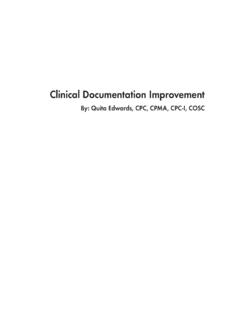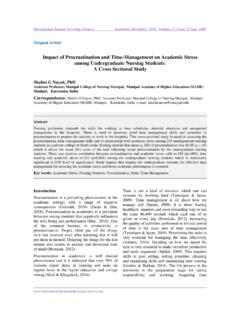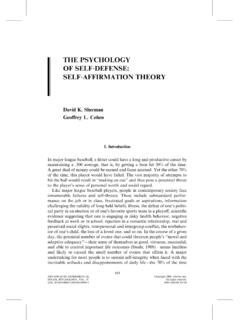Transcription of GCE Chemistry A
1 Oxford Cambridge and RSA Examinations GCE Chemistry A Unit H432A/01: Periodic table, elements and physical Chemistry Advanced GCE Mark Scheme for June 2017 2 OCR (Oxford Cambridge and RSA) is a leading UK awarding body, providing a wide range of qualifications to meet the needs of candidates of all ages and abilities. OCR qualifications include AS/A Levels, Diplomas, GCSEs, Cambridge Nationals, Cambridge Technicals, Functional Skills, Key Skills, Entry Level qualifications, NVQs and vocational qualifications in areas such as IT, business, languages, teaching/training, administration and secretarial skills. It is also responsible for developing new specifications to meet national requirements and the needs of students and teachers. OCR is a not-for-profit organisation; any surplus made is invested back into the establishment to help towards the development of qualifications and support, which keep pace with the changing needs of today s society.
2 This mark scheme is published as an aid to teachers and students, to indicate the requirements of the examination. It shows the basis on which marks were awarded by examiners. It does not indicate the details of the discussions which took place at an examiners meeting before marking commenced. All examiners are instructed that alternative correct answers and unexpected approaches in candidates scripts must be given marks that fairly reflect the relevant knowledge and skills demonstrated. Mark schemes should be read in conjunction with the published question papers and the report on the examination. OCR will not enter into any discussion or correspondence in connection with this mark scheme. OCR 2017 H432/01 Mark Scheme June 2017 3 Annotations available in RM Assessor Annotation Meaning Correct response Incorrect response Omission mark Benefit of doubt given Contradiction Rounding error Error in number of significant figures Error carried forward Level 1 Level 2 Level 3 Benefit of doubt not given Noted but no credit given Ignore H432/01 Mark Scheme June 2017 4 Subject-specific Marking Instructions INTRODUCTION Your first task as an Examiner is to become thoroughly familiar with the material on which the examination depends.
3 This material includes: the specification, especially the assessment objectives the question paper the mark scheme. You should ensure that you have copies of these materials. You should ensure also that you are familiar with the administrative procedures related to the marking process. These are set out in the OCR booklet Instructions for Examiners. If you are examining for the first time, please read carefully Appendix 5 Introduction to Script Marking: Notes for New Examiners. Please ask for help or guidance whenever you need it. Your first point of contact is your Team Leader. H432/01 Mark Scheme June 2017 5 SECTION A Question Answer Marks Guidance 1 D 1 2 D 1 3 C 1 ALLOW +6 in the box 4 C 1 5 B 1 ALLOW 20 in the box 6 C 1 7 A 1 8 D 1 9 C 1 10 A 1 11 A 1 12 C 1 ALLOW in the box 13 B 1 ALLOW in the box 14 C 1 15 B 1 Total 15 H432/01 Mark Scheme June 2017 6 SECTION B Question Answer Marks Guidance 16 (a) (i) HAlHHH 1 IGNORE no brackets, no charge or wrong charge Circles not needed ALLOW different sign for extra electron, HAlHHH DO NOT ALLOW 4 dots and 4 crosses (b) NH4+: tetrahedral AND ( ) NH2.
4 Non-linear AND ( ) 2 ALLOW 109 110( ) ALLOW 104 105( ) ALLOW bent, v-shaped, angular IGNORE planar, not straight H432/01 Mark Scheme June 2017 7 Question Answer Marks Guidance (c) (i) NH3 has hydrogen bonding OR PH3 does not have hydrogen bonding Hydrogen bonding is stronger OR More energy to overcome hydrogen bonding 2 ORA throughout Assume that comparison is with PH3 DO NOT ALLOW response that implies covalent or ionic bonds breaking (ii) AsH3 / As has more electrons (than PH3 / P) in AsH3, stronger/more induced dipole dipole interactions OR stronger/more London forces (than PH3) OR more energy required to overcome induced dipole dipole interactions 2 ORA throughout ALLOW larger electron cloud ALLOW forces OR bonds for interactions ALLOW instantaneous/temporary induced dipole interactions ALLOW dispersion forces IGNORE van der Waals / vdW IGNORE permanent dipole dipole DO NOT ALLOW response that implies covalent or ionic bonds breaking Total 7 H432/01 Mark Scheme June 2017 8 Question Answer Marks Guidance 17 (a) Ba(OH)2 + 2 HCl BaCl2 + 2H2O 1 ALLOW multiples IGNORE state symbols (even if wrong) (b) Increasing size.
5 Atomic radius increases OR more shells OR more (electron) shielding Attraction Nuclear attraction decreases OR (outer) electron(s) experience less attraction Ionisation energy Ionisation energy decreases OR less energy needed to remove electron(s) 3 FULL ANNOTATIONS WITH TICKS, CROSSES, CON, etc MUST BE USED IGNORE more orbitals OR more sub-shells Alternative must refer to shells ALLOW Energy levels for shells ALLOW more electron repulsion between shells IGNORE just shielding (more/greater needed) IGNORE nuclear shielding IGNORE pull for attraction IGNORE electrons less tightly held IGNORE nuclear charge for nuclear attraction IGNORE easier to remove electron Energy is required ALLOW less energy to oxidise H432/01 Mark Scheme June 2017 9 Question Answer Marks Guidance (c) (i) Disproportionation: oxidation and reduction of the same element Redox: Cl is oxidised from +5 (in KClO3) to +7 (in KClO4) Cl is reduced from +5 (in KClO3) to 1 (in KCl) 3 ALLOW chlorine OR Cl for same element IGNORE species for element ALLOW after number, 5+ IGNORE ionic charges, Cl5+ IGNORE 5 (signs required) IGNORE any reference to electron loss/gain (even if wrong) ALLOW one redox mark if oxidation numbers are correct but reduction/oxidation is incorrectly assigned (ii) potassium chlorate(VII) 1 Brackets required (d) (i) Equation Ba(NO3)2(aq) + Na2SO4(aq) BaSO4(s) + 2 NaNO3(aq) Entropy change and explanation entropy decreases OR entropy change negative AND (BaSO4) solid/ppt has less disorder/ more order/ fewer ways of arranging energy/ less freedom/ less random particles/dispersal of energy 2 ALLOW multiples M2 is dependent on BaSO4(s) (even if formula is incorrect eg Ba(SO4)2(s)) seen as a product in the attempted equation as long as reactants are not solid.
6 BaSO4 solid/ppt may be assumed from BaSO4(s) seen in the attempted equation. H432/01 Mark Scheme June 2017 10 Question Answer Marks Guidance (ii) Equation I2(s) I(g) state symbols required Entropy change and explanation entropy increases OR entropy change positive AND gas has more disorder/ less order/ more ways of arranging energy/ more freedom/ more random particles / more dispersal of energy 2 DO NOT ALLOW I2(s) 2I(g) DEPENDENT on I2(s) I(g) OR I2(s) 2I(g) Total 12 H432/01 Mark Scheme June 2017 11 Question Answer Marks Guidance 18 (a) G = H T S linked to y = mx + c (somewhere) gradient = S P: H / enthalpy change Q: (temperature) for reaction to be feasible/unfeasible OR (temperature) at which feasibility changes 4 Could be: G = S T + H sign required ALLOW S = gradient ALLOW point of feasibility For Feasibility: ALLOW can take place/happen OR is spontaneous IGNORE minimum/maximum temperature (b) (i) (Species have) different states/phases 1 (ii) (Kp =) p(CO(g))4 1 Allow species without state symbols and without brackets, pCO4 , ppCO4, PCO4, p(CO4) etc.
7 DO NOT ALLOW square brackets (iii) G at 25 C G = H T S = (298 ) = (+) 467 (kJ mol 1) OR (+) 466876 (J mol 1) Non-feasibility statement Non-feasible when G > 0 OR G > 0 OR H > T S Minimum temperature minimum temperature = H S = = 962(.0) K 3 IGNORE units ALLOW (+) 467 up to calculator value of correctly rounded ECF for any positive value determined in M1 ALLOW 962 up to calculator value of correctly rounded H432/01 Mark Scheme June 2017 12 Question Answer Marks Guidance (iv) FIRST, CHECK THE ANSWER ON ANSWER LINE IF answer = , Award 3 marks. ---------------------------------------- ---------------------------- Correct expression = (4 ) ( + 4 fH(CO)) Correct subtraction using H and fH(Fe3O4) 4 fH(CO) = (4 ) ( ) + = 442(.0) (kJ mol 1) Calculation of fH(CO) formation fH(CO) = 4424 = (kJ mol 1) 3 For answer, ALLOW 111 (kJ mol 1) ---------------------------------------- ---------------------------- NOTE: IF any values are omitted, DO NOT AWARD any marks.
8 OR may be missing ---------------------------------------- ---------------------------- Common errors (+) wrong/omitted sign 2 marks (+) / / / 185 2 marks No 4CO2 (+) / 739 No 4CO2 and no CO/4 1 mark / / 117 Wrong cycle 2 marks 469 Wrong cycle, no CO/4 1 mark (+) / / / 178 1 mark Wrong cycle, no 4CO2 Used 2 marks Any other number: CHECK for ECF from 1st marking point for expressions using ALL values with ONE error only one transcription error:, for Total 12 H432/01 Mark Scheme June 2017 13 Question Answer Marks Guidance 19 (a) n(H2O2) = OR = (mol) vol O2 = 24000 = 690 cm3 Collect in 1000 cm3/1 dm3 measuring cylinder 3 ALLOW (0) dm3 2nd mark subsumes 1st mark ALLOW 1000 cm3/1 dm3 syringe Needs a name of actual apparatus, not just container measuring cylinder without volume is insufficient DO NOT ALLOW burette For other possible apparatus, contact Team Leader ALLOW volumes from 700 1000 cm3 but should be realistic apparatus, 700, 750, 800, 850, 900, 950.
9 (b) Measure mass (loss) 1 ALLOW weight for mass ALLOW take samples and titrate (remaining H2O2) H432/01 Mark Scheme June 2017 14 Question Answer Marks Guidance (c)* Please refer to the marking instructions on page 5 of mark scheme for guidance on marking this question. Level 3 (5 6 marks) A comprehensive conclusion using quantitative data from the graph to correctly determine initial rate AND half lives/gradient with 1st order conclusion for H2O2 AND determination of k. There is a well-developed line of reasoning which is clear and logically structured. Clear working for initial rate, half life/gradient and order and k. Units mostly correct throughout. Level 2 (3 4 marks) Attempts to describe all three scientific points but explanations may be incomplete. OR Explains two scientific points thoroughly with few omissions. There is a line of reasoning with some structure and supported by some evidence . The scientific points are supported by evidence from the graph.
10 Level 1 (1 2 marks) Reaches a simple conclusion using at least one piece of quantitative data from the graph. Attempts to calculate initial rate OR half life. There is an attempt at a logical structure with a reasoned conclusion from the evidence . 0 marks No response worthy of credit. 6 Indicative scientific points may include: Initial rate Tangent shown on graph as line at t = 0 s Gradient determined in range: 10 3 = 10 3 initial rate as gradient value with units: mol dm 3 s 1, For other methods contact TL evidence for 1st order 2 methods 1st order clearly linked to half-life OR 2 gradients: 1. Half life Half life shown on graph Half life range 800 1000 s Two constant half lives 50 s 2. Two gradients two rates 2 tangents shown on graph at c and c/2 Gradient at c/2 is half gradient at c c = mol dm 3, gradient = 10 3 AND c = mol dm 3, gradient = 10 3 For chosen method, conclusion: H2O2 is 1st order Determination of k 2 methods k clearly linked to rate OR half-life: k = rate[H2O2] k = 10 = 7 10 4 s 1 OR k = ln2t1/2 k = = 10 4 s 1 Total 10 H432/01 Mark Scheme June 2017 15 Question Answer Marks Guidance 20 (a) Conditions Low/decreased pressure AND high/increased temperature Pressure: Right-hand/product side has more (gaseous) moles/molecules OR left-hand side/reactant side has fewer (gaseous) moles/molecules Temperature: (Forward) reaction is endothermic / takes in heat OR reverse reaction is exothermic / gives out heat 4 ANNOTATE ANSWER WITH TICKS AND CROSSES ETC DO NOT ALLOW more atoms on right-hand side OR fewer atoms on left-hand side.













